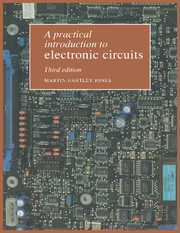Book contents
- Frontmatter
- Contents
- Preface to the third edition
- Preface to the second edition
- Preface to the first edition
- 1 Amplification and the transistor
- 2 The field-effect transistor
- 3 Thermionic valves and the cathode-ray tube
- 4 Negative feedback
- 5 Impedance matching
- 6 Semiconductor device characteristics
- 7 Amplification at high frequencies
- 8 Low-frequency signals, d.c. and the differential amplifier
- 9 Power supplies and power control
- 10 Pulse handling and time constants
- 11 Integrated circuit analogue building bricks
- 12 Positive feedback circuits and signal generators
- 13 Digital logic circuits
- 14 Microcomputer circuits and applications
- Appendix 1 Component identification
- Appendix 2 Transistor selection
- Appendix 3 Op amp data
- Appendix 4 Digital IC connections
- Appendix 5 Interfacing to the PC
- Bibliography
- Index
3 - Thermionic valves and the cathode-ray tube
Published online by Cambridge University Press: 05 June 2012
- Frontmatter
- Contents
- Preface to the third edition
- Preface to the second edition
- Preface to the first edition
- 1 Amplification and the transistor
- 2 The field-effect transistor
- 3 Thermionic valves and the cathode-ray tube
- 4 Negative feedback
- 5 Impedance matching
- 6 Semiconductor device characteristics
- 7 Amplification at high frequencies
- 8 Low-frequency signals, d.c. and the differential amplifier
- 9 Power supplies and power control
- 10 Pulse handling and time constants
- 11 Integrated circuit analogue building bricks
- 12 Positive feedback circuits and signal generators
- 13 Digital logic circuits
- 14 Microcomputer circuits and applications
- Appendix 1 Component identification
- Appendix 2 Transistor selection
- Appendix 3 Op amp data
- Appendix 4 Digital IC connections
- Appendix 5 Interfacing to the PC
- Bibliography
- Index
Summary
Introduction
The thermionic valve was the first active (amplifying) element in electronics. Although obsolete for most small-scale amplification, the valve still finds a place where high voltages must be handled or high-power high-frequency signals are involved. In addition, the inherent characteristics of valve audio amplifiers are popular with many audiophiles. In particular, the graceful behaviour of the circuits near overload can give a subjectively clean sound at high levels. It is therefore useful for the electronic engineer to have at least a rudimentary knowledge of the valve and its circuitry. This chapter gives a brief account of valve (vacuum tube) circuits, including a description of the one thermionic device which is still extensively used: the cathode-ray tube.
Thermionic emission
In the early 1880s, Thomas Edison, having developed the carbon-filament lamp, turned his attention to the blackening of the glass bulb which occurred after some hours of use. In an attempt to intercept some of the blackening particles, he sealed a metal plate inside one of his lamps and was surprised to find that, if the plate was made positive with respect to the filament, it drew a current. For twenty years, no one was to know that this ‘Edison effect’ current was due to electrons emitted by the hot filament being captured by the positively charged plate. The term thermionic emission was coined to describe this thermal liberation of free particles, literally thermal ions.
Information
- Type
- Chapter
- Information
- A Practical Introduction to Electronic Circuits , pp. 44 - 58Publisher: Cambridge University PressPrint publication year: 1995
